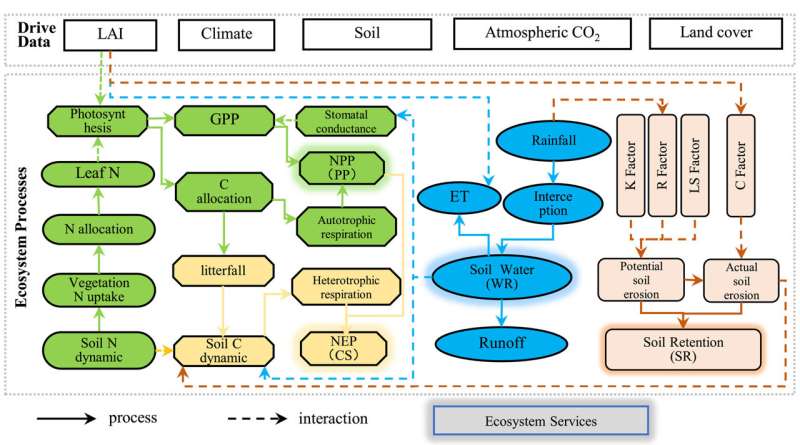Schematic representation of the CEVSA-ES model. The solid lines represent carbon, nitrogen, and water flow and the dashed lines represent the relationships among the carbon, nitrogen, and water cycles. The glowing shape represents ESs, including net primary productivity, net ecosystem productivity, soil water content, and soil retention representing the productivity provision (PP), carbon sequestration (CS), water retention (WR), and soil retention (SR), respectively. R, K, LS, and C represent rainfall erosivity factor, soil erodibility factor, topographic factor, and vegetation cover factor, respectively. Compared to the original CEVSA model, the main innovation of CEVSA-ES model was to consider soil erosion processes and its impact on carbon cycling (e.g., the light orange shapes in the figure). CEVSA-ES, Carbon and Exchange between Vegetation, Soil, and Atmosphere-Ecosystem Service.
Ecosystem services (ESs) are the ecological characteristics, functions, or processes that contribute to human wellbeing. Terrestrial ecosystems provide multiple services interacting in complex ways. However, most ecosystem services (ESs) models ignored the relationships among ESs.
To overcome this limitation, Prof. He Honglin's team at the Institute of Geographic Sciences and Natural Resources Research (IGSNRR) of the Chinese Academy of Sciences and National Ecosystem Science Data Center developed a process-based ecosystem services model (CEVSA-ES) using remotely-sensed leaf area index (LAI) data.
The study was published in the Journal of Advances in Modeling Earth Systems on May 18.
The researchers used the proposed model to evaluate four important ESs, including productivity provision, carbon sequestration, water retention, and soil retention.
"The CEVSA-ES model is a new tool to understand the complex relationships among ESs through incorporating explicit representations of the biogeochemical and biophysical processes," said Prof. He.
Compared to the traditional terrestrial biosphere models, the main innovation of CEVSA-ES was the consideration of soil erosion processes and its impact on carbon cycling. The algorithms related to carbon and water cycles were also improved through integrating remote sensing data in the new version.
In addition, a model-data fusion method was applied to optimize sensitive parameters and thus improved model performance based on multi-source observational data.
Simulation results showed good fits with ecosystem processes, explaining 95%, 92%, 76%, and 65% inter-annual variability of gross primary productivity, ecosystem respiration, net ecosystem productivity, and evapotranspiration, respectively. Meanwhile, the CEVSA-ES model with optimized parameters explained 47%-96% of the spatial and temporal variations of four ecosystem services in China.
"The process-based ecosystem services models could support exploring the mechanisms underpinning synergies and trade-offs between ES, and further guiding decision-making in ecosystem management and environmental policies," said Prof. He.
More information: Zhongen Niu et al, A Process‐Based Model Integrating Remote Sensing Data for Evaluating Ecosystem Services, Journal of Advances in Modeling Earth Systems (2021). DOI: 10.1029/2020MS002451
Provided by Chinese Academy of Sciences
























